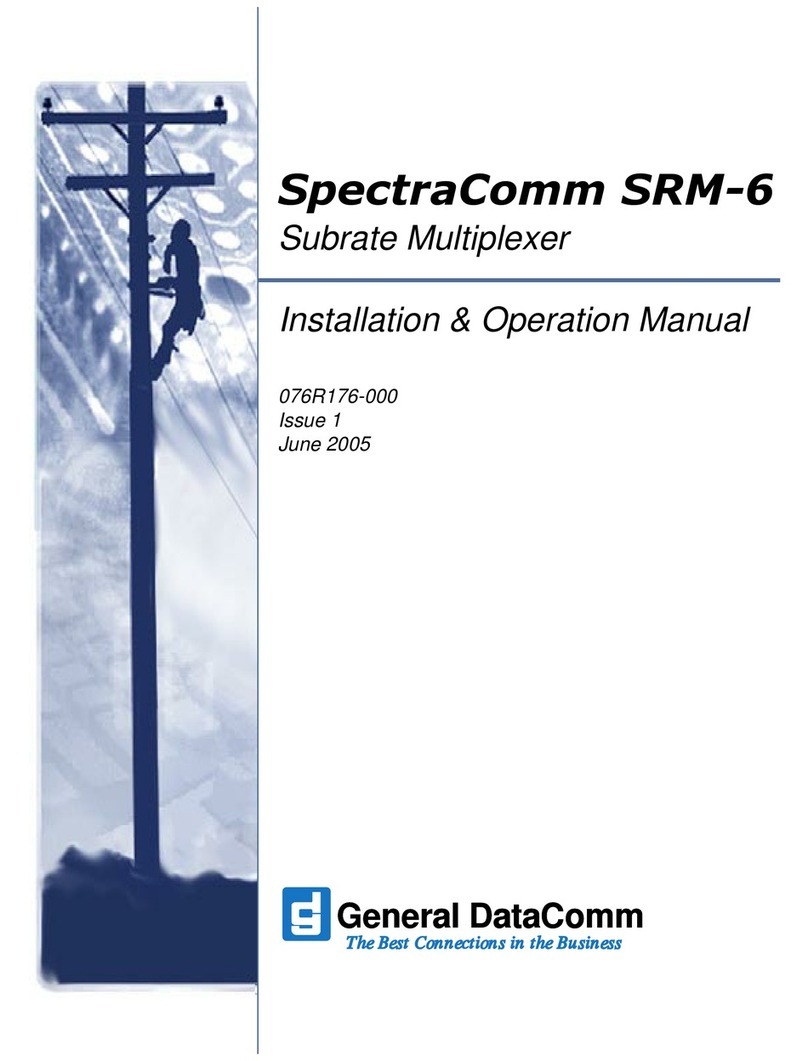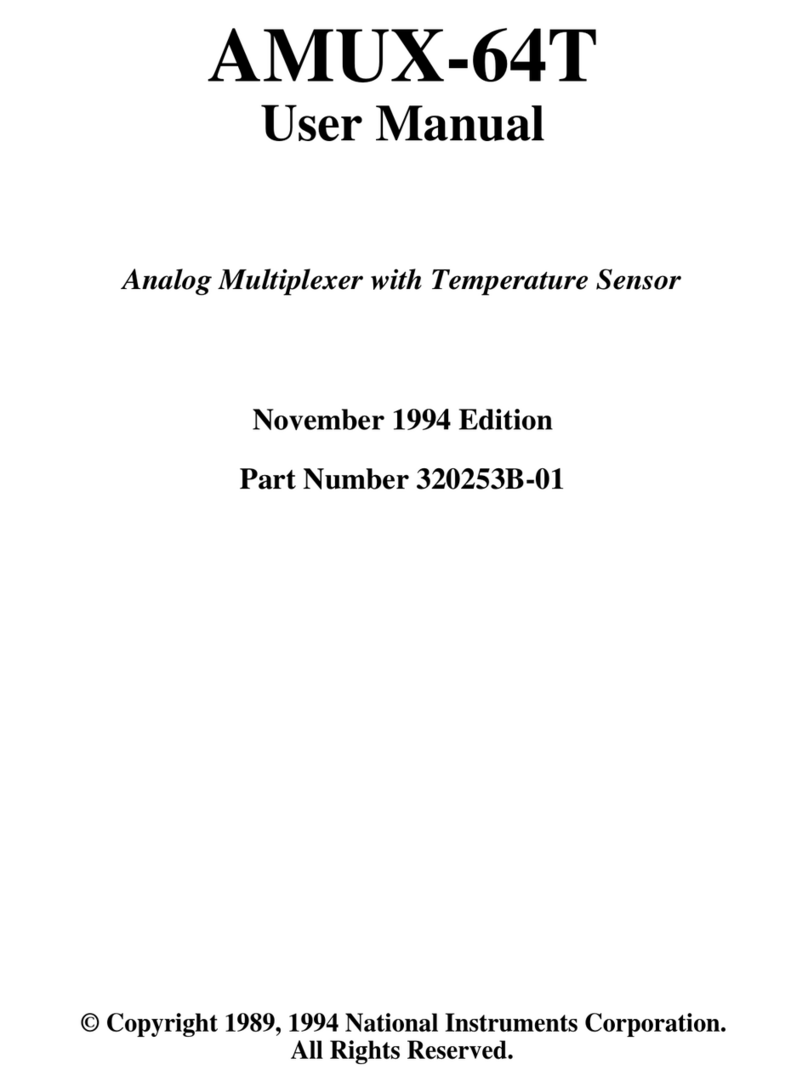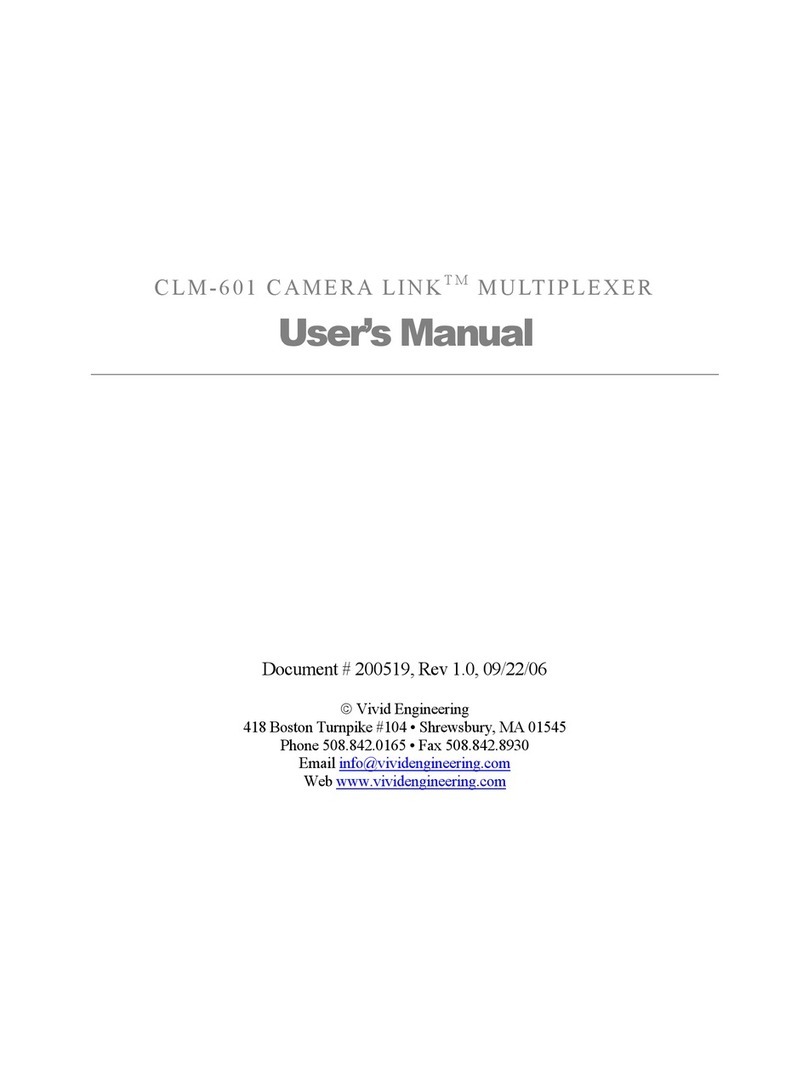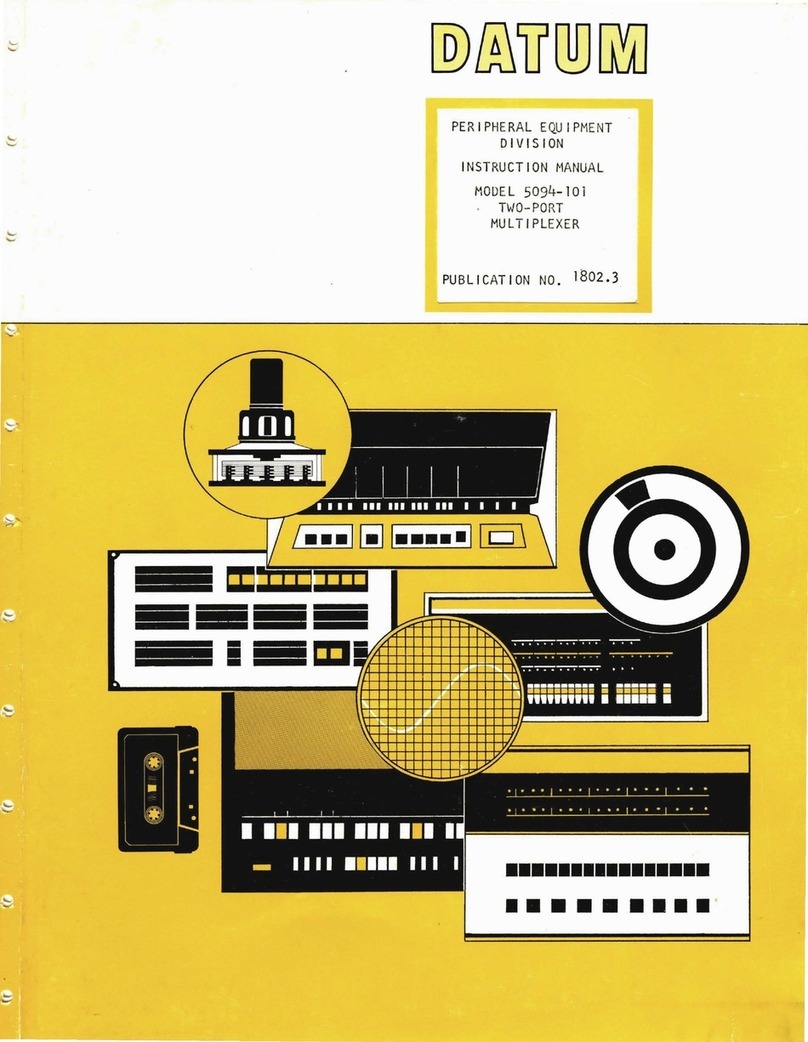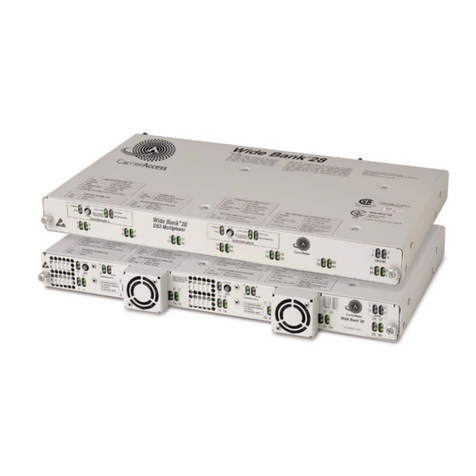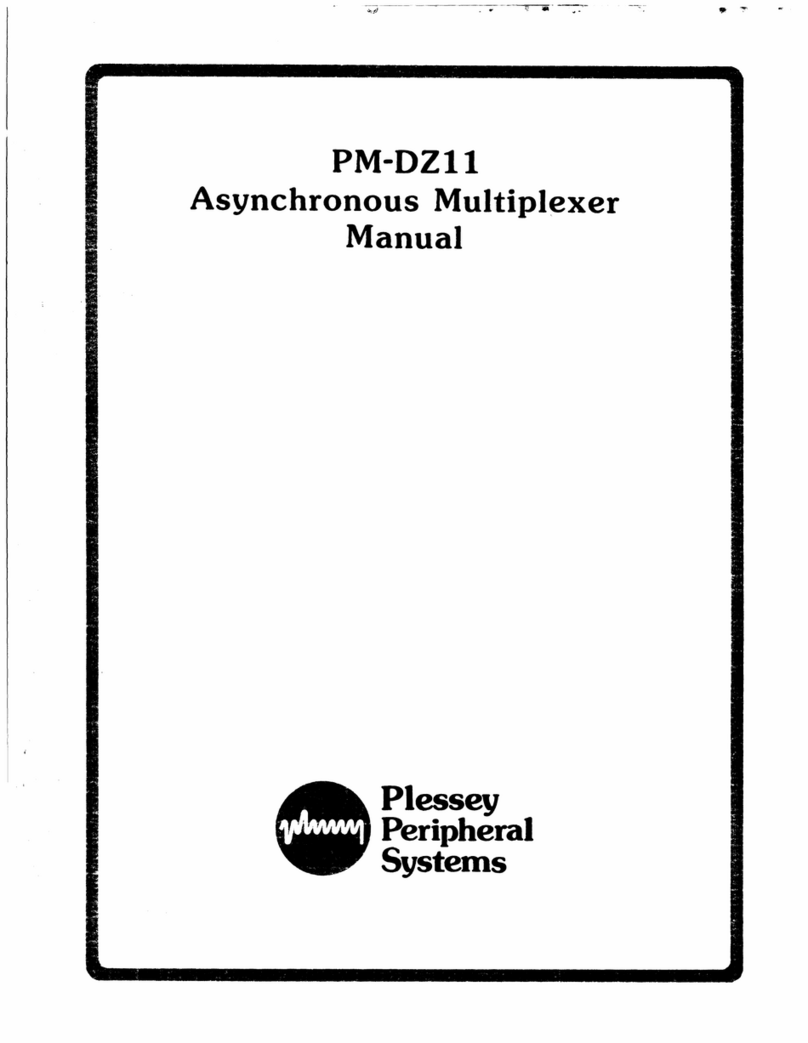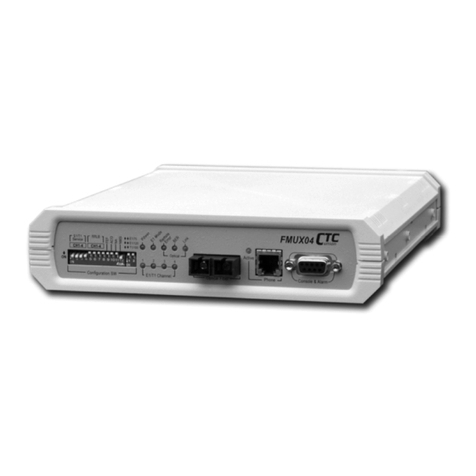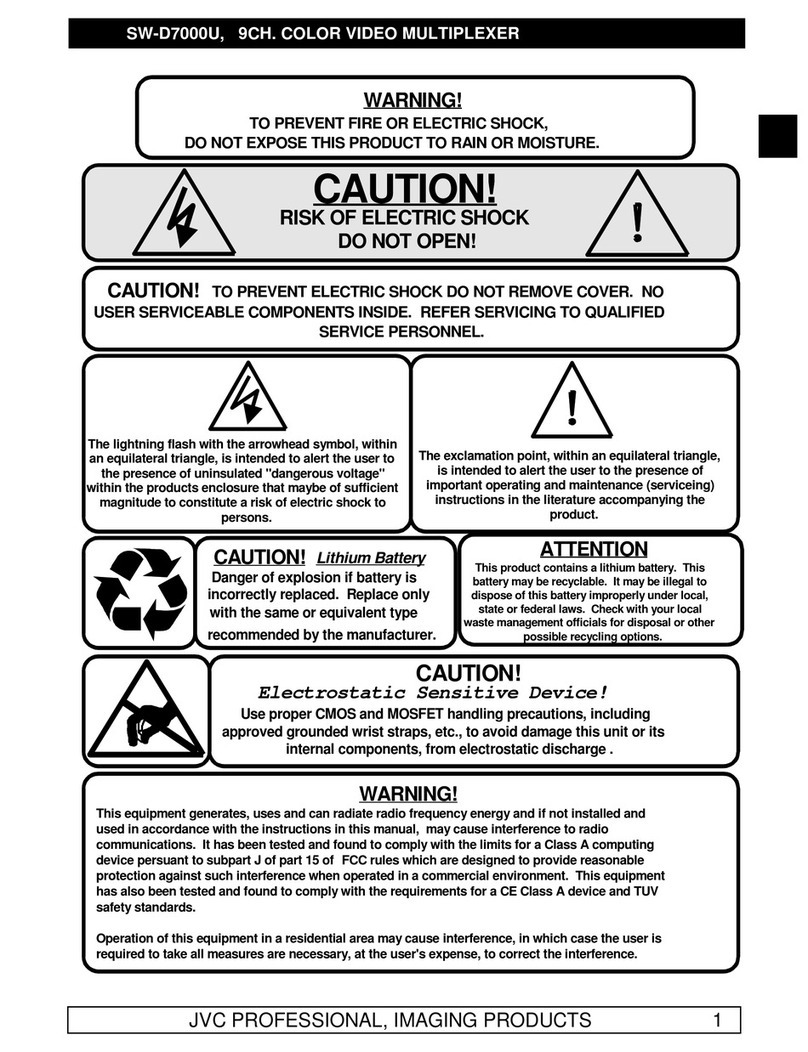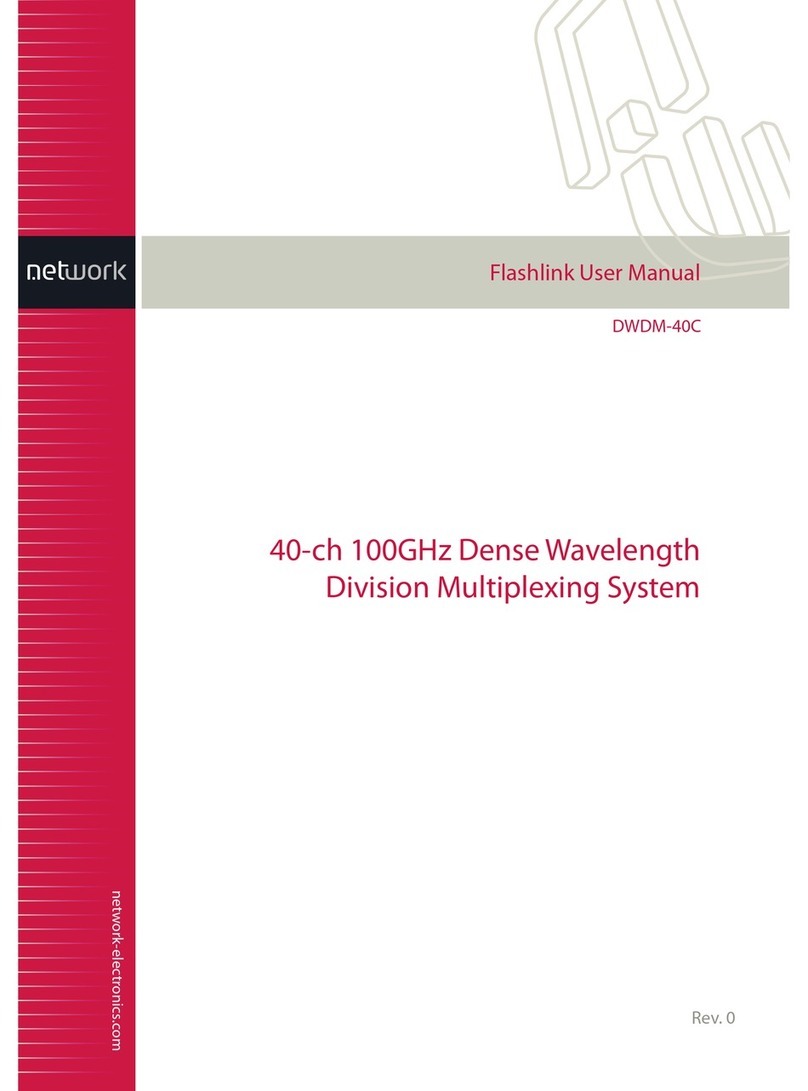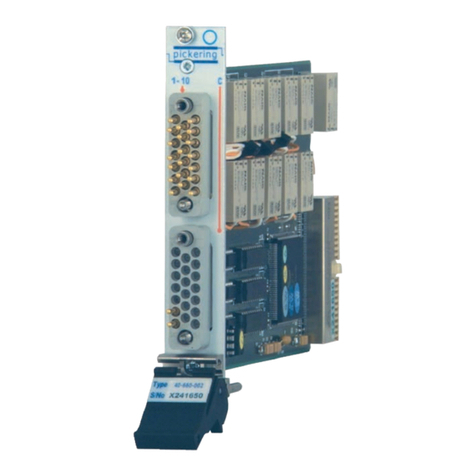General DataComm Megamux Plus 036M241 Specifications


ATTENTION!
STATIC SENSITIVE DEVICES
PROPER HANDLING AND GROUNDING
PRECAUTIONS REQUIRED
This equipment contains electrostatic sensitive devices. Use ESD pre-
cautionary procedures when removing or inserting parts or printed
circuit (pc) cards. Keep parts and pc cards in their antistatic packaging
material until ready to install.
The use of an antistatic wrist strap, connected to the grounded
equipment frame or chassis, is recommended when handling pc cards
during installation, removal, or setting of on-board option switches. Do
not use a conductive tool, such as a screwdriver or paper clip, to set
the position of the option switches.

MEGAMUX PLUS
7,0(#',9,6,21#08/7,3/(;(5
(GDC PART NO. 036M241)
This product was designed and manufactured by
General DataComm, Inc. (GDC)
Middlebury, Connecticut 06762-1299

WARNING
This equipment generates, uses, and can radiate radio frequency energy and if not
installed and used in accordance with the instruction manual, may cause
interference to radio communications. It has been tested and found to comply with
the limits for a Class A computing' device pursuant to Subpart J of Part 15 of FCC
Rules, which are designed to provide reasonable protection against such
interference when operated in a commercial environment. Operation of this
equipment in a residential area is likely to cause interference, in which case the
user at his own expense will be required to take whatever measures may be
required to correct the interference.
CRC-REQUIRED NOTIFICATION
This equipment is a Class A digital apparatus which complies with the Radio
Interference Regulations, CRC c.1374.
PUBLICATION NOTICE
This manual has been carefully compiled and checked for accuracy. The
information in this manual does not constitute a warranty of performance.
Furthermore, GDC reserves the right to revise this publication and make changes
from time to time in the content thereof. GDC assumes no liability for losses
incurred as a result of out-of-date or incorrect information contained in this
manual.
READERS COMMENTS
Comments regarding this manual should be addressed to:
Publication Department
Tech Center
General DataComm, Inc.
Middlebury, Connecticut
06762-1299
PROPRIETARY NOTICE
This publication contains information proprietary and confidential to General
DataComm, Inc. Any reproduction, disclosure, or use of this publication is
expressly prohibited except as General DataComm, Inc., may otherwise authorize
in writing.
Copyright, General DataComm, Inc., 1991

Rev. 4, October 1986
FCC-REQUIRED NOTIFICATION
FOR USERS OF FCC-REGISTERED EQUIPMENT
Read before using this technical manual or installing subject equipment.
This equipment complies with Part 68 of the Federal Communications Commission (FCC) Rules and
Regulations. Connection of data communication equipment to the public telephone network is regu-
lated by the FCC Rules and Regulations. These regulations require:
A. All connections to the telephone network must be made through standard plugs and telephone
company provided jacks or equivalent.
B. Connection of this equipment to party lines and coin telephones is prohibited
C. If the telephone company asks you what equipment is connected to the telephone line, tell them to
which line the equipment is connected, and give them the FCC Registration number and Ringer
Equivalence number of the equipment. These numbers can be found on a label located on the
back of the front panel on all DataComm-type equipment and on the underside or rear panel of
other equipment.
D. If you experience trouble, disconnect the equipment from the telephone line to determine if the
equipment is malfunctioning. If it is, remain disconnected until the problem is corrected. Should
this equipment cause harm to the telephone network, the telephone company may discontinue
your service temporarily. If possible they will notify you in advance. But if advance notice is not
practical, you will be notified as soon as possible. You will be informed of your right to file a
complaint with the FCC.
E. The telephone company may change its communication facilities, equipment, operations, and
procedures where reasonably required for operation. If this occurs, the telephone company will
notify you in writing.
F. IL is the user's obligation to notify the telephone company prior to disconnecting equipment
from 1.544 Mbps digital service.
G. According to Part 68 of the FCC Rules and Regulations, customers are not authorized to repair or
modify this equipment. Any repair or modification will null and void the FCC registration and the
warranty of this equipment.

CANADIAN DEPARTMENT OF COMMUNICATIONS (DOC) REQUIRED
NOTIFICATION
FOR USERS OF DOC-CERTIFIED EQUIPMENT
Read before using this technical manual or installing subject equipment.
The Canadian Department of Communications label identifies certified equipment. This certification
means that the equipment meets certain telecommunications network protective, operational, and safety
requirements. The Department does not guarantee the equipment will operate to the user's satisfaction.
Before installing this equipment, users should ensure that it is permissible to be connected to the facili-
ties of the local telecommunications company. The equipment must also be installed using an acceptable
method of connection. In some cases, the company's inside wiring associated with a single line individual
service may be extended by means of a certified connector assembly (telephone extension cord). The
customer should be aware that compliance with the above conditions may not prevent degradation of
service in some situations.
Repairs to certified equipment should be made by an authorized Canadian maintenance facility desig-
nated by the supplier. Any repairs or alterations made by the user to this equipment, or equipment mal-
functions, may give the telecommunications company cause to request the user to disconnect the
equipment.
Users should ensure for their own protection that the electrical ground connections of the power utility,
telephone lines, and internal metallic water pipe system, if present, are connected together. This pre-
caution may be particularly important in rural areas.
Caution: Users should not attempt to make such connections themselves, but should contact the appro-
priate electric inspection authority, or electrician, as appropriate.


036R660-E1
(55$7$#6+((7
FOR
MEGAMUX PLUS TDM
OPERATOR'S INSTRUCTIONS
Publication No. 036R660-000, Issue 9
OVERVIEW
The VLBRV (Very Low Bit Rate Voice) or VLBRV/FAX Channel Module is an analog voice
channel card for the MEGAMUX PLUS TDM. It provides voice encoding algorithms that max-
imize voice channel bandwidth utilization while offering low bit rate values of 9600, 4800 and
2400 bps. The VLBRV Channel Module is used in transmission applications to maximize avail-
able bandwidth. Applications include use in digital services such as ASDS (FT-1), ADN, satellite
and in feeder applications in which a customer needs to integrate both voice anddata. Voice com-
munication is two-way simultaneous (full duplex). The VLBRV Module mountsinto the MEGA-
MUX PLUS channel or expansion shelf.
This errata sheet covers all aspects of the VLBRV Channel Module configuration, diagnostics,
alarm and status scans as seen on the MEGAMUX PLUS supervisory controller screens.
DEFINING VLBRV CHANNEL PARAMETERS
Channel parameters are selected in a logical sequence. You must first specify the number of the
channel that you wish to configure. Once a channel number is selected, you enter the voice chan-
nel type. Once a channel type is selected, there are a range of parameters to be selected. You are
not allowed to select these parameters until a channel type is specified. Figure 1 shows how the
VLBRV channel parameters are configured.
FIGURE 1. CHANNEL PARAMETERS
Channel Number
The channel number associates a set of channel parameters with a VLBRV Channel Module in
the MEGAMUX PLUS TDM shelf. The channel number is determined by the positionof the VL-
BRV Channel Module in the shelf. Channel numbers range from 1 up to a maximum of 54 (you
must have one expansion shelf for a system with up to 38 channels, and two expansion shelves
for a 54-channel system).
CURRENT PARAMETERS FOR CHANNEL #01 CONFIGURATION AM
CHN CIRCUIT CIRCUIT BAUD T-R CLK TID-IR OR VF-DB-LEVEL I/F TID
# TYPE NAME RATE M/S DATA STOP M S TYPE MODE/DELAY
01 VLBRV MIKE1 9.6K ___ ___ 0.0 0.0 VC_1 ___

036R660-E1
2
Circuit Type
The circuit type entry defines the type of voice signal that the channel multiplexes. The selection is
determined by the equipment connected to the channel. The circuit type must also be supported by
the VLBRV Channel Module associated with the channel number. The VLBRV Channel Module
receives and transmits VF (Voice Frequency) signals. A primary task of the VLBRV Channel Mod-
ule is to convert input voice to a synchronous format, and convert output data to the original voice.
When using the VLBRV Channel Module, the circuit type is VLBRV or VLBRV/FAX.
Circuit Name
The VLBRV channel may be assigned a circuit name. This name is associated with the channel, and
appears in configuration, status, and diagnostics displays. Status and diagnostic routines that in-
volve the channel may be invoked by circuit name as well as circuit number.
Baud Rate
A baud rate is specified for every MEGAMUX PLUS channel. When a configuration is activated,
the TDM sends the entered baud rate to each VLBRV Channel Module which selects the proper
tinning signal from the MEGAMUX PLUS clock bus. For the VLBRV Channel Module, you can
select either 9600, 4800 or 2400 bps.
Transmit-Receive Clock
Not used on the VLBRV Channel Module.
TID-IR or Data/Stop Bits
Not used on the VLBRV Channel Module.
VF dB Levels
The output level of the VLBRV Channel Module is selected as a channel parameter. The level may
be specified in arange of +1.5 dB to-6.0dB, with 0.5 dB between each level (a total of 16 selectable
levels). Output levels are selected separately for Node M and Node S channel outputs.
This level is an adjustment to an absolute output level selected on the VLBRV Channel Module.
The output level is set to 0 dBm or +7 dBm by the position of a DIP switch. Generally, that switch
is set according to the requirements of the PBX or voice termination system to which the VLBRV
Channel Module is connected. The setting of this parameter adjusts the voice output above orbelow
the level set by the switch, to compensate for cable attenuation which offset the proper output levels
of the VLBRV channel. You may change this level as part of the Diagnostics routines. The Rcv dB
routine allows you to make the same level selections that are made when configuring the VLBRV
Channel Module. When either routine is complete, the controller asks whether changes to the output
levels should be changed. If changes are saved, the dB level entry for that channel configuration is
changed. This change occurs for the specified channel number in all stored configurations where
the channel is still configured far voice.

3
036R660-E1
Alarm Cut-Off (ACO)
The VLBRV has the capability to generate alarms indicating failures related to the VLBRV
Channel Module's operation. Alarms are indicated through front panel indicators, messages dis-
played in the system alarm scan, or by the VLBRV Channel alarm scan. When alarm cut-off
(ACO) is selected, the VLBRV Channel Module cannot report alarm conditions to the system.
ACO is useful when an alarm condition has been noted, but the VLBRV Channel Module con-
tinues to generate alarm messages. When ACO is implemented, it prevents further messages from
entering the Alarm Scan displays and filling message buffers. This ensures that the alarm scan
reports only new alarms, and reflect only new problems that occur in the network. When the VL-
BRV Channel Module is set for ACO, the Alarm indicator on its frontpanel remains litto indicate
this condition.
ACO may be selected for all VLBRV Channel Module's in a configuration. This action prevents
the reporting of channel alarms by the alarmscan. The alarm scan listcontains only major alarms
(those that indicate a system-level problem). When ACO is set On for all channels, it cannot be
turned Off again (except in version 3.20 and later) for all channels simultaneously; it may only
be turned Off on a channel by channel basis, or when a change is made to the configuration.
Interface Type (I/F Type )
The VLBRV Channel Module voice interface type arrangement supports E and M signaling. M
is an input control signal (input to the voice channel) and E is an output control signal. The signal
state of an M-lead at one channel interface is multiplexed through the system and transmitted at
the opposite end interface as an E-lead output. The interface type is identified as I/F type VC-1
(shown below).
I/F CONTROL [NAMES]
MODE M NODE S
SEND : M M
RCV : E E
Switches and jumpers on the VLBRV Channel Module selects one of the five E and M signaling
types.Each type is adifferent representation ofthe E and M On and Off statesusing voltage levels
or open and closed circuits. Since any of these types result in On or Off states for the signals, they
are not differentiated by the supervisory port display. You may display and change the states of
the EandM signals using Control State routines providedas part of the Diagnosticsroutines. This
feature allows you to disable the VLBRV Channel Module when required. However, if you save
changes made to the voice channel controls, the control states are changed in the channel config-
urationalso. Besure to notesuch changes ifyou makethem. A disabledVLBRV Channel Module
remains disabled until action is taken through Configuration or Diagnostics routines to restore
them.

036R660-E1
4
VLBRV CHANNEL PARAMETERS CONFIGURATION
Once the correct aggregate rate is entered, VLBRV channel parameters are entered or modified as
required by the configuration. To select the VLBRV channel parameter display (if it is not already
on the screen), select the Configuration routine from the Main Menu. Next, select the appropriate
Modify/Display TDM Configuration routine from the Configuration Menu. Finally, select the
Modify Channel Parameters routine from the Modify/Display TDM Configuration menu.
A Current Parameters display similar to the one below is displayed in Figure 2.
FIGURE 2. CURRENT CHANNEL PARAMETERS
You select the VLBRV Channel Module parameters by specifying a channel number, entering the
circuit (channel) type, and it's appropriate parameters. The cursor position keys step you sequen-
tially through each applicable parameter, and the status line gives specific directions on the keys
required to make each selection. The system only allows you to pick parameters that are related to
the circuit type. For that reason, the channel parameters other than channel number and type are
only accessible after a circuit type is entered. When you select a circuit type, default values are dis-
played for the channel parameters associated with the circuit type. These default values are dis-
played and stored until you change them.
The name of the TDM configuration can also be changed during channel configuration. The follow-
ing paragraphs describe the requirements for selecting each parameter, including active keys and
circuit type restrictions.
CHN #
The CHN # (channelnumber) entry is made using the numeric keysor up and down cursor position
keys (entering A initiates the aggregate rate display as described above). The entry becomes valid
as soon as you use the cursor position key to move to another channel parameter. MEGAMUX
PLUS channels are numbered from 1 through 54, according to their position in the shelf.
CIRCUIT TYPE
The circuit type is determined by the type of channel equipment and MEGAMUX PLUS channel
card associated with the speci-fied channel number. The voice channel choice for this entry is: VL-
BRV. The selection is made by pressing the up or down cursor position keys until the correct type
is displayed and becomes valid when you use the cursor position keys to move to another channel
parameter.
CURRENT PARAMETERS FOR CHANNEL #01 CONFIGURATION AM
CHN CIRCUIT CIRCUIT BAUD T-R CLK TID-IR OR VF-DB-LEVEL I/F TID
# TYPE NAME RATE M/S DATA STOP M S TYPE MODE/DELAY
01 VLBRV TEST2 4.8K ___ ___ 0.0 0.0 VC_1 ___

5
036R660-E1
CIRCUIT NAME
The circuit name is a channel identifier assigned by the user. The name may be up to six alpha-
numeric characters in length: Thename may include anypunctuation or non-standard char-acters
available on the keyboard. However, the first character entered must be an alpha character. You
enter the circuit name by typing the desired characters. The selection becomes valid when you
use the cursor position keys to move to another channel parameter.
Once a circuit name is entered, status scans, alarm scans and diagnostics may be applied to a
channel using a circuit name specification.
BAUD RATE
The baud rate of a channel is determined by the baud rate of the equipment connected to the chan-
nel. With the cursor positioned at BAUD RATE, you begin the selection by pressing Return.
The standard VLBRV Channel Module rates (9600, 4800 or 2400 bps) appear below the channel
parameters display. To select a standard rate, use the cursor position keys to position the cursor
at the required rate. Press Return to complete the selection. The selected rate appears in the pa-
rameter display under BAUD RATE, and the REMAINING BANDWIDTH display is revised.
T-R CLK
Not configured for the VLBRV Channel Module.
DATA-STOP BITS
Not configured for the VLBRV Channel Module.
VF-DB-LEVEL
This entry specifies the attenuation oramplification required for the voice output level on the VL-
BRV Channel Module. The nominal level is set by a DIP switch to 0 dBm or +? dBm. This entry
allows the nominal level to be further adjusted between +1.5 dB and -6.0 dB in 0.5 dB steps. This
feature provides compensation for cable and equipment losses. The up and down cursor position
keys step through the output level range. This entry becomes valid when the cursor is placed on
another channel parameter.
I/F TYPES
The InterfaceType display defines each selected control signal by assigninga mnemonic. For the
VLBRV Channel Module, the interface type is VC-1. To select the interface type, with the cursor
positioned below I/F TYPE press the up or down cursor position keys. As each interface type is
selected, the associated display appears below the other channel parameters. The interface type
is valid when the cursor is moved to another position.
TID MODE/DELAY
Not configured for the VLBRV Channel Module.

036R660-E1
6
ACO ON/OFF
Alarm Cutoff selects whether alarms in the VLBRV Channel Module are reported and logged in
the alarm scan, or indicated by the Common Alarm Plus Module front panel indicators. This feature
is usefulwhen a malfunctioning channelproduces enough alarms to preventalarm reporting on oth-
er channels. Use the up and down cursor keys to choose the ON (alarms cut off) or OFF (alarms
reported) selection. This entry becomes valid when the cursor is placed at another channel param-
eter.
CONFIGURATION
The name of the configuration that the channel is being installed in is located in the upper right-
hand corner of the screen. The configuration name may contain up to ten alphanumeric characters,
and may be changed as part of the modification of any channel. Any characters available on the key-
board may be entered, however, the first character entered mustbe an alphabetic character. To enter
a configuration name, with the cursor positioned at the presently displayed configuration, type the
desired name. The new name becomes valid when the cursor is moved to another parameter.
VLBRV CHANNEL MODULE TESTS
The VLBRV Channel Module tests exercises the VF (analog) and digital components. The VF in-
terface of the voice channel is the channel interface with telephone equipment.
The VF signal from the channel interface is digitized into data that can be multiplexed with other
VLBRV Channel Module data. A loopback or data origin on the analog side of the channel refers
to the channel telephone equipment interface. A loopback or data origin on the digital side refersto
the digital interface with MEGAMUX PLUS common set components.
Rcv dB Level - The output level of the VLBRV Channel Module can be adjusted within a range of
+1.5 dB to -6.0 dB, with 0.5 dB between each step. The levels are set separately for the VLBRV
Channel Module at each node. This adjustment is the same as the VF-dB-LEVELS channel param-
eter, and becomes the output level adjustment. You can save the Rcv dB level as part of this routine.
When changing voice output levels through the Rcv dB levels routine, it is preferable to save the
selected levels in configuration memory. Otherwise, a discrepancy exists between stored channel
parameters, and actual channel operation. If a different configuration is activated, and the levels set
in the new configuration are the same as the stored parameters for the previously active configura-
tion, the voice levels set by the Rcv dB levels routine remain (the channel's voice output level does
not change to the levels set in the newly activated configuration).
VF Idle
The VF Idle Test evaluates the noise level in the system. The analog input of the VLBRV Channel
at the data origin node is grounded. The loopback may be local, with the loopback point at the same
node as the data origin, or may be remote, with the loopback point at the opposite node from the
data origin VLBRV Channel. The VLBRV Channel at the data origin evaluates the noise level in
the loopback path, and develops an error count (in this test, errors are significant deviations from
ground in the returned VF signal). Figure 3 shows the loopback paths of a VF Idle test with Node
M as the data origin point.

7
036R660-E1
Digital Test
The Digital Test uses the digital circuitry of the data origin node VLBRV Channel to generate a
digital "quiet channel pattern." If the data origin node is the same as the loopback point (a local
loopback) the digital pattern is looped back at the interface between the Transmit/Receive Logic
Plus module and the VLBRV Channel Module. If the loopback point specified is at the opposite
node from thedata origin (a remote loopback) the digitalpattern is looped back withinthe digital
circuitry of theremote VLBRV Channel Module. The data originVLBRV Channel Module eval-
uates the returned digital signal, and develops an error count which is displayed in the channel
status scan. This test is used after a VF Idle Test, to determine if a noise problem is originating in
the digital or VF section of the VLBRV Channel Module. Figure 4 illustrates the loopback paths
of a Digital Test.
User Data Test
The User Data test requires that external test equipment be connected to the data origin node VL-
BRV Channel to generate test signals and evaluate them. Loopbacks may be selected at the data
originnodechanneldigitalinterface,orthe opposite-endchanneldigitalinterface.Figure5shows
the loopback paths of a User Data Test with a Node M data origin.
The following instructions applyto VLBRV channel datapath tests (separate instructions aregiv-
en below for Rcv dB levels):
1. If you are using external testequipment, connect the test equipment to the originating chan-
nel interface.
2. Select Channel diagnostics from the Diagnostics Functions Menu. Specify the channel by
name or number. Selecting channel diag-nostics suppresses all Out-Of-Sync alarms on the
VLBRV Channel Module.
3. Using the cursor position and Return key, select the Data Path Tests.
4. When the Data Path Test display appears, use the up and down cursor position keys to po-
sition the cursor at the desired test.
5. Use the left and right cursor position keys to move the cursor to the DATA ORIGIN or
LOOPBACK POINT fields. Use the up and down cursor position keys to alternate between
Node M and Node S for data origin or loopback point.
6. Whenthedesireddataoriginandloopbackpointhave beenselected, press Returnto initiate
the test. If you are using external test equipment to generate test signals, begin the signal
generation. The channel Diagnostics Menu returns to the screen, and the channel status
scan reports the test. If the selected test has displayed test results, the results are displayed
in the status scan.
7. To terminate the test, select Data Path Tests from the Diagnostic Menu. When the Data Path
Test display appears, select STOP TEST and pressReturn. The status scan will indicate the
test has completed.

036R660-E1
8
The following instructions apply to the Rcv dB Levels routine:
1. 1. Selectthe Channeldiagnosticsand Data Path Test.Use the up ordown cursor position keys
to select RCV dB. Use the left and right cursor position keys to move the cursor to the Data
Origin field. Use the up and down cursor position keys to select the Node M or Node S VL-
BRV Channel Module for output level adjustment.
2. When a node is selected, press Return. The following appears:
SET RCV dB FOR NODE
M 0.0
Use the up and down cursor position keys to select a level. The selected levelbecomes active in the
system. To exit the routine, enter Control X. The following message is displayed:
SAVE CHANGES Y/N
If you enter Y, the level is stored in non-volatile memory for each configuration in which the VL-
BRV Channel Module has been configured. The channel output remains at the selected level until
the routine is applied to the VLBRV Channel Module again, or another configuration is activated.
If youenter N, the configurationis not stored. However, the VLBRV Channel Module'soutput level
remains at the selected level until the routine is applied to the channel again, or any configuration
is activated. The Channel Diagnostics menu returns to the screen, and another diagnostic routine
are applied to the VLBRV Channel Module.

9
036R660-E1

036R660-E1
10
VLBRV CHANNEL STATUS SCAN
The Status Scan provides information on the current state of the MEGAMUX PLUS system. Dis-
plays report either system status or the condition of individual MEGAMUX PLUS components.
The displays are real-time, with immediate reporting of new system developments. Two routines,
General or Specific Status Scan, control the type of scan displayed.
The General Status Scan provides an overview of the system, reporting primarily on the operation-
aL/Non-operational status of each component in the MEGAMUX PLUS system. The display is or-
ganized according to the MEGAMUX PLUS channel shelves, and reports Alarm, ACO, or Unused
status for each channel, as well as the Auto Frame, Aggregate Interface, Power Supply, and the
Transmit/Receive, Clock Generator, and Expansion Modules. The display also indicates which
configuration is currently in use.
The Specific Status Scan provides detailed information on the VLBRV Channel Module. When a
channel status scan is selected, a VLBRV Channel may be specified by it's circuit name or channel
number. Separate Alarm and Control Status Scans may also be selected for each VLBRV Channel
Module.-
When the Specific Status routine is selected from the Status Scan Menu, the following menu is dis-
played:
*--- STATUS SCAN DISPLAY MENU---*
COMMON (TR/CK/EX)
AUTO FRAME
AGGREGATE
POWER SUPPLY
CHANNEL
Use the cursor position and Return keys to select a specific scan from the menu. If you select a Sta-
tus Scan for the VLBRV Channel Module, you must specify the channel number or name as part of
the selection process. VLBRV Channel alarms are also displayed. Up to eight alarms are included
in the display at any time. New alarms replace existing alarms when they occur. (If the alarms occur
rapidlyinastatusdisplay,use thealarmscan foramorecompletelistofrecentalarms.)Ifyou desire
to delete existing displayed alarms, press Return. The following prompt appears:
DELETE DISPLAYED ALARMS Y/N?
Simultaneouslypress the Yand Returnkey to delete thedisplayed alarms. The items in each display
are defined in the following paragraphs.

11
036R660-E1
VLBRV Channel Status Scan
When you select the Channel Status Scan from the Specific Scan menu, the following prompt ap-
pears:
ENTER CIRCUIT NAME OR NUMBER:
The VLBRV channel may be specified either by channel number or by the name assigned in the
configuration.
To select the VLBRV Channel Module by name, type the name and press Return. To select the
VLBRV Channel Module by channel number, type the channel number, and press Return. The
following appears:
* STATUS SCAN FOR CIRCUIT: MIKE 1C HAN #1
* CONFIGURED AS VLBRV, 9600HZ
CHANNEL TEST : NO TEST
ACO : OFF
CLOCK : NODE M OK NODE M OK
CHANNEL TYPE : NODE M VLBRV NODE S VLBRV
__________________________________________________________________________
SPECIFIC CHANNEL STATUS MENU
ALARM SCAN
CONTROL STATES SCAN
The following items are displayed on the VLBRV Channel Status Scan:
CHANNEL TEST
This item reports any type of test being performed on the VLBRV Channel Module. If no test is
running, NORMAL is reported. Otherwise, the test type, data origin point, and loopback point are
reported.
ACO - ON
Indicates that Alarm Cut-Off has been selected for the VLBRV Channel Module, and no alarms
are being reported. OFF indicates that Alarm Cut-Off has not been selected for the channel.
CLOCK
OK, RCV CLK BAD, TX CLK BAD or T/R CLK BAD may be reported. OK indicates that the
clock signals for both transmit and receive clock signals for the channel are good. Any other re-
port indicates that the specified clock signal is not in proper operating condition. (For asynchro-
nous, isochronous or transition-encoded channels, the item reports the existence of a data
overflow in the channel. For example, TX CLK BAD would indicate an overflow of transmit data
in the channel.)
CHANNEL TYPE
This item reports the type of channel card in the slot (as opposed to the configured Circuit Type).
For the VLBRV Channel Module, VLBRV is displayed here.
When the ALARM SCAN or CONTROL STATES SCAN are selected from the SPECIFICSTA-
TUS MENU, the displays are as follows:

036R660-E1
12
ALARM SCAN
Reports the most recent alarm messages associated with the VLBRV Channel Module. After dis-
playing the messages, you have the option of deleting them.
CONTROL STATES SCAN
Displays the names and states of each channel control signal. Four possible signal states are report-
ed as follows.
ON - The control signal is logically ON, under control of channel-connected equipment.
OFF - The control signal is logically OFF under control of channel-connected equipment.
F-ON - The signal is forced to an ON state by the MEGAMUX PLUS system, either through the
configuration or diagnostics.
F-OFF - The signal is forced to an OFF state by the MEGAMUX PLUS system, either through the
configuration or diagnostics.
VLBRV ALARM SCAN
The Alarm Scan Routine allows you to display or print stored MEGAMUX PLUS alarm messages.
Up to 149 alarm messages can be saved by the system. Once 149 alarms are accumulated, each new
alarm replaces the oldest alarm stored in the alarm buffer. The alarm message reports the MEGA-
MUX PLUS node, component, and the time and date of alarm occurrence.
The alarm message format is illustrated by the following example:
NODE S : CHANNEL#3 CFG ERROR 10/21 04:47
NODE S indicates that the alarm message originated at Node S. CHANNEL indicates that the VL-
BRV Channel Card number at Node S is the location of the alarm condition. CFG ERROR is the
actual alarm, in this case, a configuration error. The date and time of alarm occurrence is displayed
to the right of the alarm message. Each channel alarm message is defined in Table 1. When Alarm
Scan is selected from the MEGAMUX PLUS Main Menu, an Alarm Scan Menu appears:
*--ALARM SCAN MENU--*
SCREEN DISPLAY
HARD COPY
DELETE DISPLAYED ALARMS
DELETE INACTIVE ALARMS
Each routine is described in the following paragraphs.
Screen Display
The screen display routine displays all stored alarms in a format suitable for the CRT screen. When
you select the routine from the Alarm Scan Menu, alarm messages are displayed until the screen is
filled; the next page of alarms (if any) is then displayed after a one-second pause. Press the Control
and S key simultaneously to freeze the display. Press the Control and Q key to continue aftera Con-
trol S. Control X or the Return key returns you to the Alarm Scan Menu. You are not allowed to
clear the alarm buffer (Reset Displayed Alarms) until you have used this routine to display all
alarms.

13
036R660-E1
Hard Copy
When theHard Copyroutine is selected, the printer (connected tothe MEGAMUX PLUS system
printerport), prints alarm messages stored in the alarm buffer and any additional alarm messages
as they occur. The following operating instructions are applicable to Lear Siegler Models ADM-
12 and ADM-12 Plus terminals. To print alarm messages, proceed as follows:
1. Select the Hard Copy routine from the Alarm Scan menu.
2. The screen displays TURN ON PRINTER. Turn the printer ON.
3. Depress theControl, Shift and Aux Port keys simultaneously. Now press Return. All alarm
messages stored in the alarm buffer will be printed. New alarm messageswill be printed as
they occur.
4. To exit the routine, press the Aux Port and Control X key simultaneously. The screen re-
turns to the Alarm Scan menu.
Delete Displayed Alarms
The Delete Displayed Alarms routine clears all stored alarms in the MEGAMUX PLUS alarm
buffer. The routine is intended to be used after you have displayed or printed the stored alarms.
To successfully clear all alarms, you must first use the Screen Display routine to view alarm mes-
sages. If you do not display all messages, a message reports the number of undisplayed alarms
still in the alarm buffer:
14 UNDISPLAYED ALARM(S) NOT DELETED
When the Delete Displayed Alarms routine is selected, after viewing all alarms, the Alarm Scan
Menu remains on the screen. The buffer is cleared without any change in the display. The Screen
Display routine will determine if new alarm messages were generated after the clear operation
was accomplished.
Delete Inactive Alarms
The Delete Inactive Alarms routine clears all inactive alarms from the alarm buffer (viewed on
the alarm scan display). Inactive alarms are those alarm conditions that no longer exist, or have
been reported again by a new alarm message. If you select the screen display routine, the screen
reports an alarm deleted message, together with the date and time.
Table of contents
Other General DataComm Multiplexer manuals
Popular Multiplexer manuals by other brands
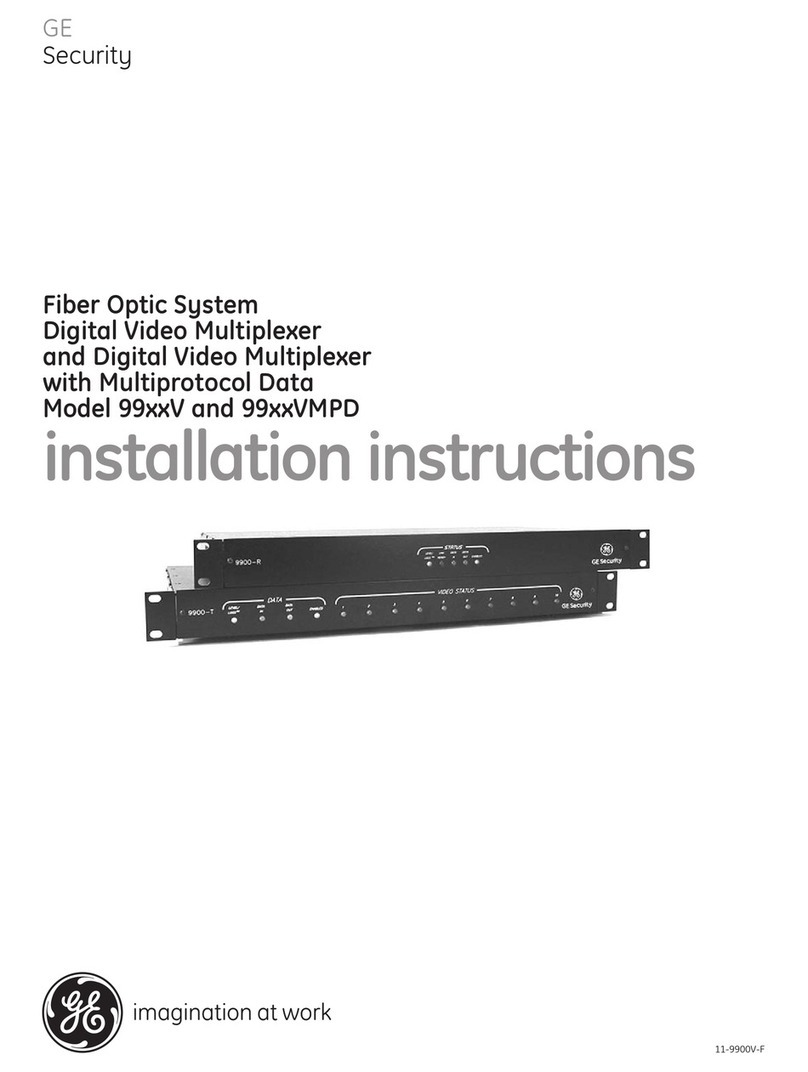
GE
GE 99V installation instructions

Pickering
Pickering 40-670C user manual
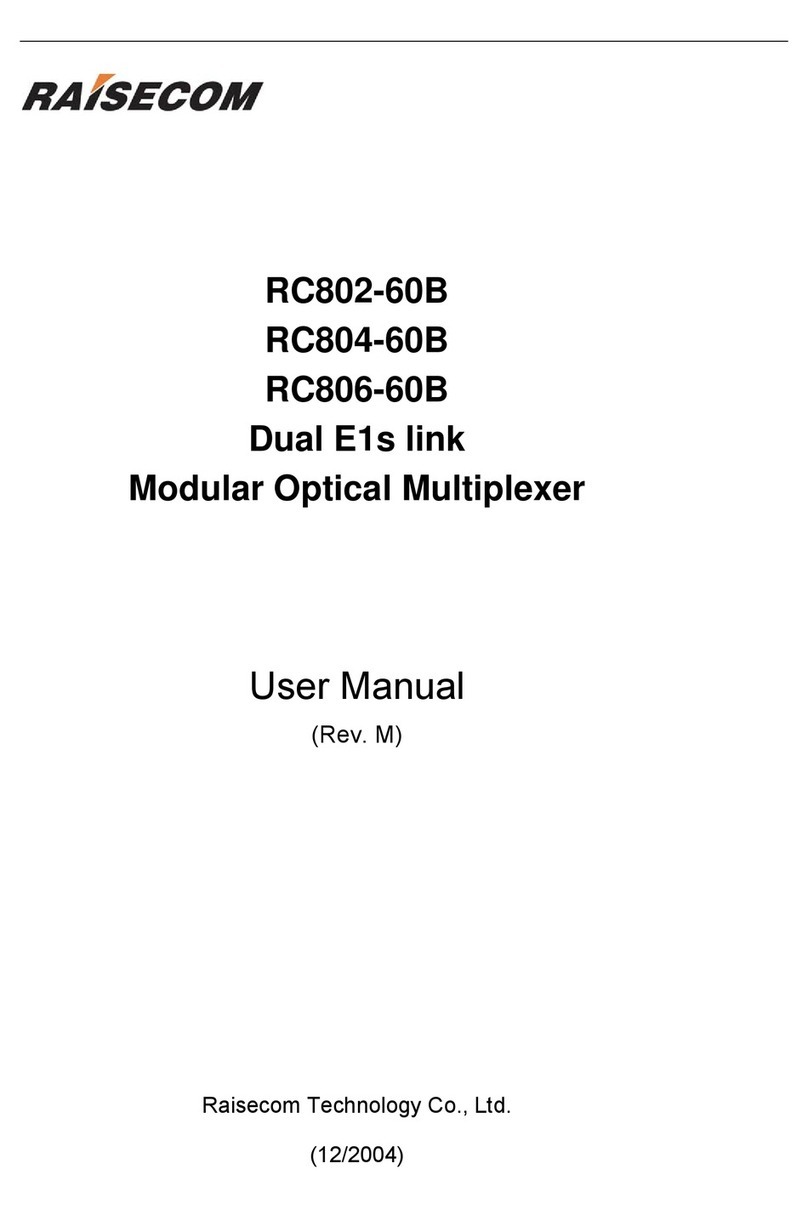
Raisecom
Raisecom RC802-60B Series user manual
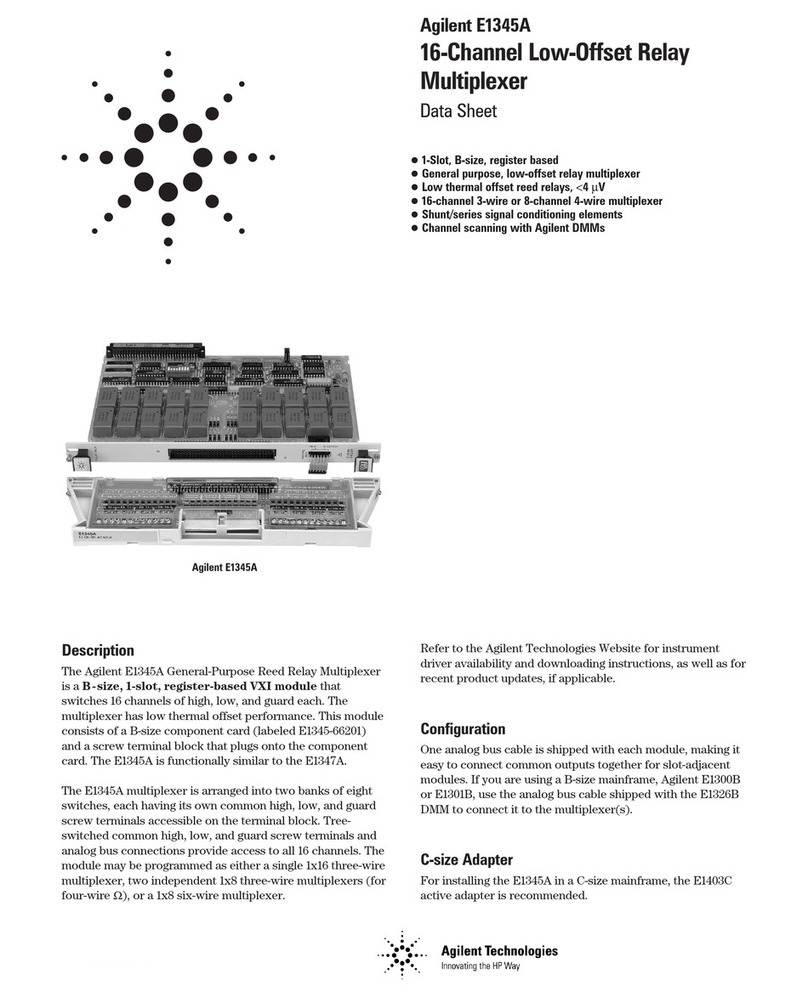
Agilent Technologies
Agilent Technologies Agilent E1345A datasheet
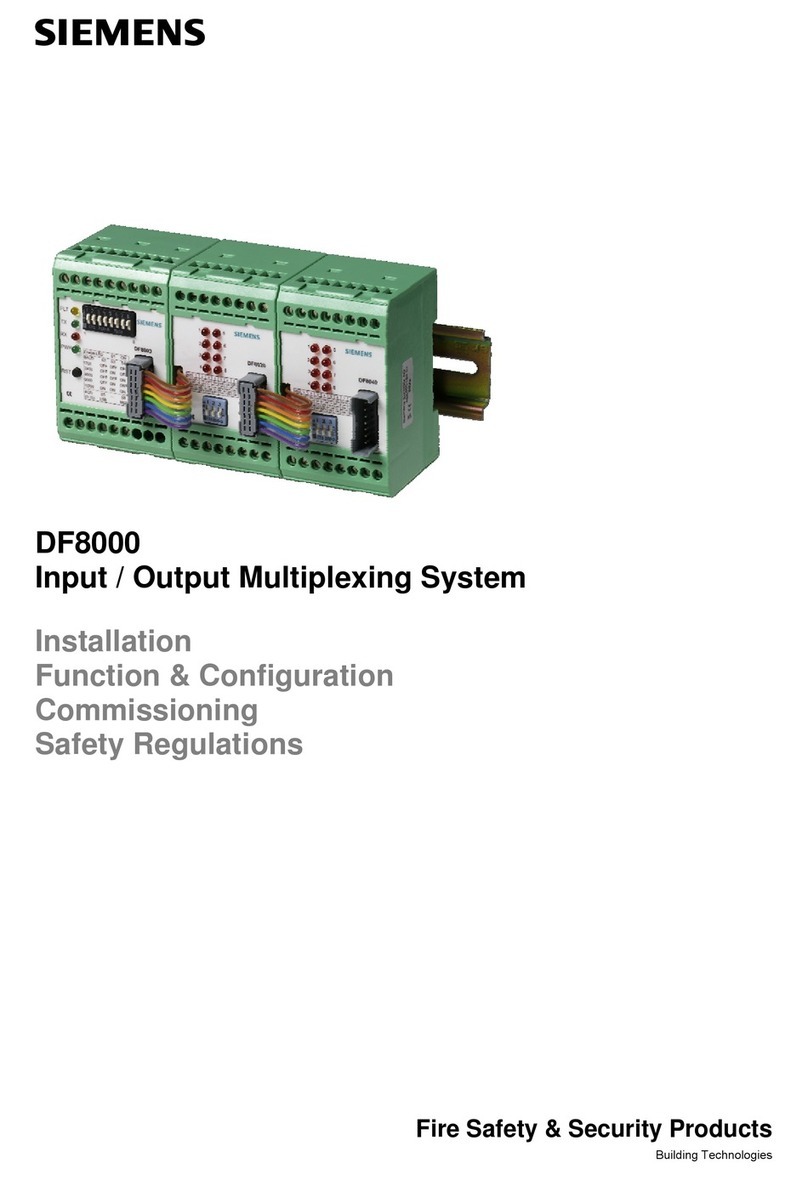
Siemens
Siemens DF8000 Installation Function & Configuration Commissioning Safety Regulations

Pickering
Pickering PXI 40-617 user manual
